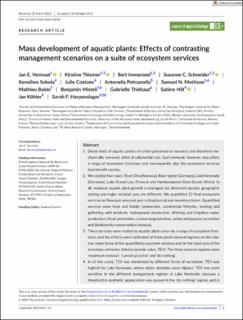Mass development of aquatic plants: Effects of contrasting management scenarios on a suite of ecosystem services
Vermaat, Jan E.; Thiemer, Kirstine; Immerzeel, Bart; Schneider, Susanne Claudia; Sebola, Keneilwe; Coetzee, Julie; Petruzella, Antonella; Motitsoe, Samuel N.; Baldo, Mathieu; Misteli, Benjamin; Thiébaut, Gabrielle; Hilt, Sabine; Köhler, Jan; Harpenslager, Sarah F.
Peer reviewed, Journal article
Published version

Åpne
Permanent lenke
https://hdl.handle.net/11250/3102785Utgivelsesdato
2023Metadata
Vis full innførselSamlinger
- Publikasjoner fra CRIStin - NINA [2364]
- Scientific publications [1392]
Originalversjon
10.1111/1365-2664.14539Sammendrag
1. Dense beds of aquatic plants are often perceived as nuisance and therefore mechanically removed, often at substantial cost. Such removal, however, may affect a range of ecosystem functions and consequently also the ecosystem services that benefit society. 2. We studied five cases: River Otra (Norway), River Spree (Germany), Lake Kemnade (Germany), Lake Grand-Lieu (France) and Hartbeespoort Dam (South Africa). In all, nuisance aquatic plant growth is managed, but dominant species, geographic setting and major societal uses are different. We quantified 12 final ecosystem services as flows per area and year in biophysical and monetary terms. Quantified services were food and fodder production, commercial fisheries, hunting and gathering wild products, hydropower production, drinking and irrigation water production, flood prevention, carbon sequestration, active and passive recreation and biodiversity conservation (nonuse). 3. These services were related to aquatic plant cover via a range of ecosystem functions, and the effects were estimated of three plant removal regimes on the relative importance of the quantified ecosystem services and on the total sum of the monetary estimates (total economic value, TEV). The three removal regimes were ‘maximum removal’, ‘current practice’ and ‘do nothing’. 4. In all five cases, TEV was dominated by different forms of recreation. TEV was highest for Lake Kemnade, where visitor densities were highest. TEV was most sensitive to the different management regimes in Lake Kemnade, because a threshold in aesthetic appreciation was passed in the ‘do-nothing’ regime, and in Hartbeespoort Dam, because of the effect on boating and angling. In the other cases, the different removal regimes had little effect on the estimated TEV. 5. Synthesis and applications. Since recreation dominated the estimated societal benefits in the studied ecosystems, also where provision of hydropower, drinking water or irrigation water were relevant, effects on recreation should be a core consideration in the management of nuisance aquatic plants. Furthermore, aquatic plant management strategies will benefit from taking into account the differences in perceived nuisance among different categories of recreative users before engaging in costly removal. aquatic macrophytes, ecosystem functions, integrated weed management, introduced invasive plants, keystone species, mass development
